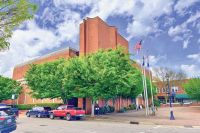Keats’ Roman home honors one of our great poets
 It is not yet ten o’clock on this Saturday morning in late June, and already Rome’s Spanish Steps and the Piazza di Spagna below the steps are crowded with tourists, hucksters, and shopkeepers. After nearly a week of visiting ruins, marble-decked churches, and museums crammed full of antiquities and art, I am taking a vacation from my vacation and have walked this piazza to visit the house where John Keats died in February of 1821.
It is not yet ten o’clock on this Saturday morning in late June, and already Rome’s Spanish Steps and the Piazza di Spagna below the steps are crowded with tourists, hucksters, and shopkeepers. After nearly a week of visiting ruins, marble-decked churches, and museums crammed full of antiquities and art, I am taking a vacation from my vacation and have walked this piazza to visit the house where John Keats died in February of 1821.
I arrive early, hoping to beat the swarm of tourists coming to this shrine just at the foot of the Spanish Steps. When the door does swing open, I feel a fool for not realizing that there will be no throngs of pilgrims in this place. This house is not the Coliseum, after all, not even the Piazza Navona. It is merely the memorial to a poet who lived here less than four months before coughing out his last breath.
When I try to pay the five-euro entrance fee with a 50, the young English woman at the counter becomes flustered because she doesn’t have the change. So back I go into the piazza, looking for something to buy — a small gift, a snack for later — when suddenly I again feel like a fool. Returning to the house, I climb the winding stairs and pull out my credit card. The woman then explains, again bashfully and apologetically, that I will need to buy something else to meet the limit for cards, and so I pick up a small book about the house and then a larger one, at her suggestion, on Keats himself. The card slides into the machine, and all is well.
She asks for my pack, and I ask in return if I can carry my laptop through the museum to make notes. I show her my press card from The Smoky Mountain News, and she nods, “Yes, of course.”
So finally I am alone with Keats. Only four other visitors enter the house during the 90 minutes I am there. Another attendant, again young, female, and English, tells me that the house is busier when groups of school children visit. When I ask whether scholars journey here — the house contains a large collection of Romantic literature and resources — she tells me some do, but that she has never met one.
And so it is quiet and I am alone with the poet. My progress through the house is slow, as I read each plaque and study each document. The more I read, the more I absorb, the more I realize how gallantly this man lived and how young he died, and how with that death we lost much too early one of the great poets not only of the Romantic period, but of all time.
Related Items
Darkling I listen; and for many a time
I have been half in love with easeful Death,
Called him soft names in many a mused rhyme,
To take into the air my quiet breath ….
— John Keats, “Ode To A Nightingale”
John Keats could have died an angry man, for he had reasons to be frustrated with the hand dealt him by life. His parents died young. As a result, he became close to his two brothers, who were his greatest supporters, but one of them soon moved to America and the other died of consumption, what today we would call tuberculosis. Keats nursed his poor brother through this disease to his death, a foreshadowing of his own future. The young woman he loved so tenderly, Fanny Brawne, he could not marry because of his illness. And though he came to Rome for the more temperate climate and in hopes of a cure, John Keats quickly realized that he had little time left to live. Yet he met his end with courage and with love for those around him.
It’s a sad story. His bedroom, which overlooks the piazza, is particularly touching. His devoted friend, Joseph Severn, cared for him in this room, heating up his meals in the fireplace, carrying him on occasion into the next room for a change of scenery, reading to him, and calling for medical help when necessary. None of the furniture is original — Vatican law then proscribed the burning of all furniture in a room when such a death occurred in the belief that this conflagration would prevent the spread of disease — but over the last century the curators of the house have restored the room with period pieces.
The dwelling is officially called the Keats-Shelley House, even though Shelley never visited Keats here, because the collection of books and papers celebrates the later Romantic writers: Shelley, Keats, and Byron. Other writers did come to pay homage to the poet. In 1877, Oscar Wilde, ever dramatic, prostrated himself on Keats’ grave and declared it “the holiest place in Rome.” Elizabeth Barrett Browning visited the house, and the rooms contain notes made on “Ode To A Nightingale” by the Argentinian writer Borges. During the Second World War, when the Allies had driven the Germans from the city, the house became a favorite visiting place for British and American troops.
In 1908, admirers of John Keats, including the president of the United States, Theodore Roosevelt, and the kings of Britain and Italy, saved 29 Piazza di Spagna from destruction. In the video that introduces visitors to the house, Prince Charles, who serves as a trustee for the house, makes an appearance and remarks at the end of his brief address that “It is our duty to ensure the survival of this place for generations to come.”
To tour this house and to understand the Prince’s words, simply Google “Keats-Shelley House Rome.”
LAST WEEK: Scotland pays homage to its writers









